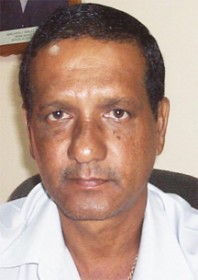Minister of Agriculture Robert Persaud and a team on Saturday reassured rice, cash-crop and livestock farmers at Den Amstel that measures are being intensified to help them to combat the prevailing drought-like conditions.

At a meeting convened at the Den Amstel cattle farmers’ building in Region Three, Persaud noted that at first farmers had been cooperating, cognizant of the fact that irrigation depends on the seasonal rainfall. He said too the conservancies and waterways started out at maximum level but as the drought-like conditions continued, persons had begun to cut and remove drainage structures and pumped water from the main canals. They had also stopped sharing resources.
GINA also said the National Drainage and Irrigation Authority (NDIA) had previously taken a decision not to follow the standard operating procedure of dipping the levels of the conservancy when the rainy season approaches. Persaud said the NDIA and the Water Users Association have been working closely with rice farmers and farmers’ groups to create a more localised monitoring committee to facilitate a functional system. Farmers also benefited from field pipes to facilitate drainage and irrigation needs. The minister said additional interventions costing $200M were also undertaken.
These entail deploying mobile pumps on all sea shores, two pumps to pump water into the conservancy at Boerasirie Creek and six pumps to pump water into the East Demerara Water Conservancy, Dawa and the Mibicuri and Corentyne areas.
Regional
developments
Region Three Chairman Julius Faerber said though El Nino is presenting several pressing challenges, water in the conservancies is currently very low and as such is not being channelled into farmlands at the required speed. He said pumps would have to be used to channel water into farmlands.
Faerber also said he was disappointed that some farmers have resorted to vandalising drainage structures and warned that persons caught in this act will be dealt with condignly.
“If we allow the system to work, then I’m quite certain that all of the farmers would be able to benefit from that exercise.
But if we tamper with the structures, you would find farmers who have pumps benefiting, while the smaller farmers would not benefit,” he said. Faerber then appealed to them to allow the systems in place to work.
According to GINA some critical areas that have been affected are Vreed-en-Hoop and Pouderoyen. “The reason is that the water at this end gets into your system first before it gets to the other end so we find that end is far more critical than this area here…however, we are working to ensure that the entire region gets whatever water is in the system no matter how small it is. This is to ensure that each farmer benefits,” Faerber said.
Meanwhile, Agriculture Sector Develop-ment Unit’s Senior Engineer Frederick Flatts said major drainage and irrigation works have started in the Vergenoegen, Bonasika and Den Amstel areas which will be followed by works at Vreed-en-Hoop, La Jalousie, the canals polder, Golden Grove, Victoria and Crabwood Creek. The works executed under the Unit are funded by the Inter-American Development Bank and the government. Earth works have also started in the three areas to the tune of $1.1B. These are being executed by the NDIA. Flatts also said to date works to the Vergenoegen, Bonasika and Den Amstel areas is 63% completed and are expected to be completed by year end.





